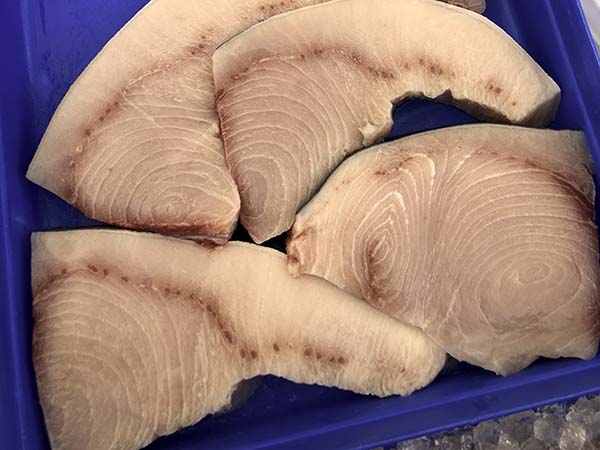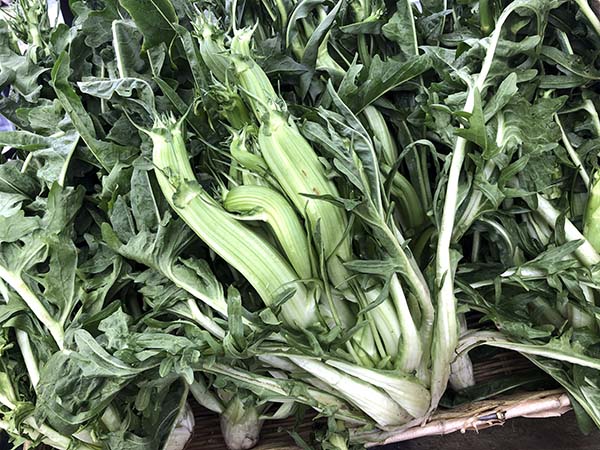
I bought more swordfish than I really should have, because, while the individual steaks at the fishers’ stall yesterday were really too large for one, they would have been even less satisfactory for two, especially for two of us who really love swordfish.

Warren, who works the stall and is also one of the fishermen, steered me to the swordfish bucket when I asked what would be my best choice if it turned out I’d have to wait until the next day to cook a fish. Then, while complimenting the quality of the particular catch (I’ve learned to always pay close attention to his words and his body language when I’m contemplating – out loud – what to bring home; sometimes he volunteers a suggestion, and it’s always on target) he pointed to the rim of pale flesh just under the long line of skin; I think he said something about rich belly meat.
The main vegetable was puntarelle, which I’ve been delighted to have experienced at home a number of times before, but apparently never as it really should be. At the Greenmarket on Wednesday I came across a form that must be pretty close to what would be found in Rome, and for the first time ever we enjoyed really crunchy curled strands of this wonderful mild chicory. The farm that produced our puntarelle is more than halfway up the state of Vermont, where the climate isn’t anything like that of the farms where cicoria asparago is grown in Lazio.

- two really beautiful swordfish steaks (20 ounces) from American Seafood Company in the Union Square Greenmarket, marinated for more than half an hour in a mixture of a couple tablespoons of olive oil, a bit of super-pungent dried Sicilian oregano, which is sold still attached to bunches of stems inside a cellophane bag at Buon Italia, one tiny yellow Brazil wax pepper from Eckerton Hill Farm, and a thinly sliced section of a red spring onion from Norwich Meadows Farm, after which the steaks were drained and covered on both sides with a coating of homemade dried breadcrumbs (to help retain the moisture, and keep it from drying out), pan-grilled over medium-high heat for 4 minutes on each side, or until barely cooked all of the way through, removed, arranged on the plates, seasoned with a little local salt, Phil Karlin’s P.E. & D.D. Seafood Long Island Sound sea salt, drizzled with some ‘tomato water’ that remained from a salsa prepared for a meal a few days earlier, a bit of juice from a small California organic Whole Foods Market lemon (Sespe Creek Organics) squeezed on top, and drizzled with a little olive oil
- one ripe red heirloom tomato from Norwich Meadows Farm, halved, sprinkled with sea salt and black pepper, arranged face down on the same grill as the swordfish, near the end of the latter’s cooking time, turned once, then arranged on the plates, tossed with chopped epazote from TransGenerational Farm, and drizzled with a little olive oil

- one ‘head’ of Puntarelle [cicoria di catalogna], an Italian chicory (28 ounces), from Tamarack Hill Farm, the outer straight leaves removed for another time, the remainder cooked pretty much as described on this site (for which I’m very, very grateful); I used ‘Chesnok Red’ garlic from Alewife Farm, local sea salt, 3 rinsed and filleted salted Sicilian anchovies from Buon Italia, one and a half tablespoons of Columela Rioja 30 Year Reserva sherry vinegar, 3 tablespoons of Whole Foods Market house Portuguese olive oil, and Whole Foods Market house whole pepper
Noting: It means nothing of course, but it is literally although only slightly remarkable, and I don’t make a big thing about coincidences anyway, but except for the wine (Galician then) and the music (more ancient in 2018), this meal was almost a duplicate of one I had prepared 13 months before, right down to the serendipitous tomato water.
- the wine was a Portuguese (Dão) white, Prunus White, Dão 2017, from Astor Wines
- the music was Gioseffo Zamponi’s 1650 opera, ‘Ulisse all’Isola di Circe’, Leonardo García Alarcón conducting the Capella Mediterranea, the Choeur de Chambre de Namur, and the Clematis Ensemble